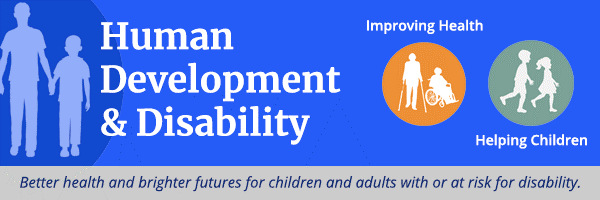DHDD Newsletter – September 2018

While you’re getting ready for cooler temperatures and pumpkin spice everything this fall, also make sure to get your flu vaccine! The CDC recommends everyone 6 months of age and older get a flu vaccine every season. Getting a flu vaccine is the most important action a person with disabilities can take to prevent flu and its complications. Learn more here!
– Dr. Georgina Peacock, Director, DHDD
dhdddirector@cdc.gov
How Far Are You from Specialty Care?

DHDD scientists recently published an article in Disaster Medicine and Public Health Preparedness entitled, Readiness for an Increase in Congenital Zika Virus Infections in the United States: Geographic Distance to Pediatric Subspecialist Care. Children with disabilities related to congenital (being born with) Zika virus infection will need care from pediatricians who specialize in the different types of care needed by children infected by the Zika virus before birth. This study explains how travel distance to certain specialty health care providers may be a barrier in getting care for a child with disabilities related to congenital Zika virus infection.
Hurricane and Other Emergency Preparedness
With September being National Preparedness Month, DHDD is helping to ensure families and communities across the nation are getting ready and staying safe. Some helpful resources include
- Emergency Partners Information Connection (EPIC) webinar: Children in Public Health Emergencies. CDC experts discussed preparedness and response for children affected by natural disasters, infectious disease outbreaks, and other emergencies.
- Keeping Children Safe. As children head back to school, parents can take a few steps to help protect their child during an emergency and reunite with them quickly and safely.
- Natural Disasters and Severe Weather response. CDC and ATSDR are working together to support local, state, and federal response to public health needs resulting from Hurricane Florence.
Check out the Children’s Preparedness Unit’s webpages for more information about how to keep children safe, and also see CDC’s Office of Public Health Preparedness and Response.
Disability Impacts All of Us

DHDD updated the “Disability Impacts All of Us” infographic with the 2016 BRFSS data from the recently updated Disability and Health Data System (DHDS) and the Morbidity and Mortality Weekly Report (published on August 17), which outlines disability prevalence and health care access disparities for people with disabilities across the country. This infographic shows in an eye-catching fashion that 1 in 4 US adults has at least one type of disability, locations in which disability is more common, health characteristics, and barriers to access to health care that are common among people with disabilities.

